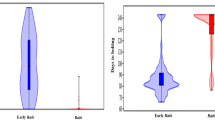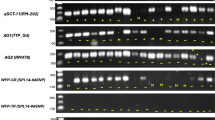Abstract
Hull-less seed trait is readily available in Cucurbita pepo, but to enhance its yield in diverse climatic conditions transfer of this trait in another related species, viz. C. moschata, is highly desirable. Consequently, a set of total 33 hull-less seeded genotypes including 31 derived from interspecific hybridization between C. pepo (hull-less) and C. moschata (hulled), and two C. pepo genotypes were evaluated for various fruit and seed traits. Analysis of variance revealed significant variation among the genotypes for fruit (fruit weight, polar and equatorial diameter) and seed (seed length, width, thickness, number of seeds, and 100-seed weight) traits. An interspecific hybridization-derived genotype, viz. HL3643-6, was comparable to check C. pepo genotypes for most of the traits. All studied traits exhibited high heritability and genetic advance, with a significant positive correlation confirming their interrelationship. Principal component analysis indicated that the first two components contributed to 82.66% of the cumulative variance, with all eight traits contributing to PC1 and seed thickness along with hundred-seed weight being the major contributors to PC2. Overall, the investigation highlighted substantial variation in the interspecific derived lines and their potential for exploitation in improving the hull-less seed trait.


Similar content being viewed by others
References
Ahmed I, Rohman MM, Hossain MA, Molla MR, Azam MG, Hasan MM, Gaber A, Albogami B, Hossain A (2022) A study on the phenotypic variation of 103 cucumber (Cucumis sativus L.) landraces for the development of desirable cultivars suitable for the changing climate. Life 12:1235. https://doi.org/10.3390/life12081235
Aruah BC, Uguru MI, Oyiga BC (2012) Genetic variability and inter-relationship among some Nigerian pumpkin accessions (Cucurbita spp.). Int J Plant Breed 6:34–41
Balkaya A, Özbakır M, Karaağaç O (2010) Pattern of variation for seed characteristics in Turkish populations of Cucurbita moschata Duch. African J Agric Res 5:1068–1076. https://doi.org/10.5897/AJAR.9000529
Bhandari HR, Bhanu AN, Srivastava K, Singh MN, Shreya HA (2017) Assessment of genetic diversity in crop plants: an overview. Adv Plants Agric Res 7:279–286. https://doi.org/10.15406/apar.2017.07.00255
Darrudi R, Nazeri V, Soltani F, Shokrpour M, Ercolano MR (2018) Genetic diversity of Cucurbita pepo L. and Cucurbita moschata Duchesne accessions using fruit and seed quantitative traits. J Appl Res Med Aromat Plants 8:60–66. https://doi.org/10.1016/j.jarmap.2017.11.003
Dhatt AS, Sharma M, Kaur B (2020) Advances in improvement of pumpkin and squashes. In: Gosal SS, Wani SH (eds) Accelerated plant breeding. Springer, Nature, Switzerland, pp 301–335. https://doi.org/10.1007/978-3-030-47298-6_11
El-Adawy TA, Taha KM (2001) Characteristics and composition of watermelon, pumpkin, and paprika seed oils and flours. J Agric Food Chem 49:1253–1259. https://doi.org/10.1021/jf001117+
Ezin V, Gbemenou UH, Ahanchede A (2022) Characterization of cultivated pumpkin (Cucurbita moschata Duchesne) landraces for genotypic variance, heritability and agro-morphological traits. Saudi J Biol Sci 29:3661–3674. https://doi.org/10.1016/j.sjbs.2022.02.057
Gong L, Paris HS, Stift G, Pachner M, Vollmann J, Lelley T (2013) Genetic relationships and evolution in Cucurbita as viewed with simple sequence repeat polymorphisms: the centrality of C. okeechobeensis. Genet Resour Crop Evol 60:1531–1546. https://doi.org/10.1007/s10722-012-9940-5
Habib A, Biswas S, Siddique AH, Manirujjaman M, Uddin B, Hasan S, Khan MMH, Uddin M, Islam M, Hasan M, Rahman M, Asaduzzaman M, Rahman M, Khatun M, Islam MA, Rahman M (2015) Nutritional and lipid composition analysis of pumpkin seed (Cucurbita maxima L.). J Nutr Food Sci 5:374
Hosen M, Rafii MY, Mazlan N, Jusoh M, Oladosu Y, Chowdhury M (2021) Pumpkin (Cucurbita spp.): a crop to mitigate food and nutritional challenges. Horticulturae 7:352. https://doi.org/10.3390/horticulturae7100352
Hussain A, Kausar T, Sehar S, Sarwar A, Ashraf AH, Jamil MA, Noreen S, Rafique A, Iftikhar K, Quddoos MY, Aslam J (2022) A Comprehensive review of functional ingredients, especially bioactive compounds present in pumpkin peel, flesh and seeds, and their health benefits. Food Chem Adv. https://doi.org/10.1016/j.focha.2022.100067
Kaur B, Garcha KS, Sandhu JS, Sharma M, Dhatt AS (2023) Interspecific hybridization for transfer of hull-less seed trait from Cucurbita pepo to C. moschata. Sci Rep 13(1):4627. https://doi.org/10.1038/s41598-023-29935-9
Kaur B, Garcha KS, Bhatia D, Khosa JS, Sharma M, Mittal A, Verma N, Dhatt AS (2022) Identification of single major QTL and candidate gene(s) governing hull-less seed trait in pumpkin. Front Plant Sci 13:948106. https://doi.org/10.3389/fpls.2022.948106
Lê S, Josse J, Husson F (2008) FactoMineR: an R package for multivariate analysis. J Stat Software 25(1):1–18. https://doi.org/10.18637/jss.v025.i01
Lee HY, Jang S, Yu CR, Kang BC, Chin JH, Song K (2021) Population structure and genetic diversity of Cucurbita moschata based on Genome-Wide High-Quality SNPs. Plants 10:56. https://doi.org/10.3390/plants10010056
Lelley T, Loy JB, Murkovic M (2010) Breeding oil seed pumpkins. In: Vollmann J, Rajcan I (eds) Handbook of plant breeding, vol 4. Oil crops Springer, New York, pp 469–492
Liu C, Ge Y, Wang DJ, Li X, Yang XX, Cui CS, Qu SP (2013) Morphological and molecular diversity in a germplasm collection of seed pumpkin. Sci Hortic 154:8–16. https://doi.org/10.1016/j.scienta.2013.02.015
Loy JB (2004) Morpho-physiological aspects of productivity and quality in squash and pumpkins (Cucurbita spp.). CRC Crit Rev Plant Sci 23:337–363. https://doi.org/10.1080/07352680490490733
Lyu X, Shi L, Zhao M, Li Z, Liao N, Meng Y, Ma Y, Zhou Y, Xue Q, Hu Z, Yang J (2022) A natural mutation of the NST1 gene arrests secondary cell wall biosynthesis in the seed coat of a hull-less pumpkin accession. Hortic Res 9:136. https://doi.org/10.1093/hr/uhac136
Manivannan N (2014) TNAUSTAT-Statistical package. Retrived from https://sites.google.com/site/tnaustat
Meru G, Fu Y, Shrestha S, Michael VNE, Dorval M, Mainviel R (2022) Genomic position and markers associated with the hull-less seed trait in pumpkin. Plants 11:1238. https://doi.org/10.3390/plants11091238
Nee M (1990) The domestication of cucurbita (Cucurbitaceae). Econ Bot 44:56–68
Noirot M, Hamon S, Anthony F (1996) The principal component scoring: a new method of constituting a core collection using quantitative data. Genet Resour Crop Evol 43:1–6. https://doi.org/10.1007/BF00126934
Paris HS (2016) Genetic resources of pumpkins and squash Cucurbita spp. In: Grumet R, Katzir N, Garcia-Mas J (eds) Genetics and Genomics of Cucurbitaceae. Springer, Cham, pp 111–154. https://doi.org/10.1007/7397_2016_3
Robinson RW, Decker-Walters DS (1997) Evolution and exploitation. In: Atherton J (ed) Cucurbits. CAB International, Oxon, UK, pp 23–77
Sivasubramanian S, Madhavamenon P (1973) Genotypic and phenotypic variability in rice. Madras Agric J 60:1093–1096
Swarup S, Cargill EJ, Crosby K, Flagel L, Kniskern J, Glenn KC (2021) Genetic diversity is indispensable for plant breeding to improve crops. Crop Sci 61:839–852. https://doi.org/10.1002/csc2.20377
Wei T, Simko V, Levy M, Xie Y, Jin Y, Zemla J (2017) Package ‘corrplot.’ Statistician 56:e24
Yadegari M, Ansari MH (2017) Study of multivariate analysis of quantitative traits in Iranian pumpkin lines. Genetika 49:425–433. https://doi.org/10.2298/GENSR1702425Y
Acknowledgements
The authors gratefully acknowledge DST-SERB, CII, and Mr. Avtar Singh Dhindsa, Proprietor of Beauscape Farms for providing financial support though Prime Minister’s Fellowship for Doctoral Research to Karmvir Singh Garcha.
Author information
Authors and Affiliations
Contributions
ASD, MS, and JSK contributed to conceptualization and designing of the research work; KSG, NV, and BK contributed to execution of field experiments and data collection; KSG, NV, BK, MS, JSK, and ASD contributed to analysis of data, interpretation and preparation of manuscript.
Corresponding author
Ethics declarations
Conflict of interest
The authors declare that they have no conflict of interest.
Additional information
Publisher's Note
Springer Nature remains neutral with regard to jurisdictional claims in published maps and institutional affiliations.
Supplementary Information
Below is the link to the electronic supplementary material.
Rights and permissions
Springer Nature or its licensor (e.g. a society or other partner) holds exclusive rights to this article under a publishing agreement with the author(s) or other rightsholder(s); author self-archiving of the accepted manuscript version of this article is solely governed by the terms of such publishing agreement and applicable law.
About this article
Cite this article
Garcha, K.S., Verma, N., Kaur, B. et al. Physio-Morphological Characterization of Interspecific Hybridization-Derived Hull-Less Seeded Lines for Fruit and Seed Traits in Pumpkin. Agric Res (2024). https://doi.org/10.1007/s40003-024-00712-y
Received:
Accepted:
Published:
DOI: https://doi.org/10.1007/s40003-024-00712-y




